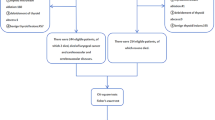Abstract
Background
There is little information about the effect of operative experience and supervision of trainees on long-term outcomes after thyroid resection for Graves’ disease (GD). The aim of this study was to compare the morbidity rate after thyroid resection performed by trainees vs consultant surgeons.
Methods
Based on a cross-sectional design analysis with a median follow-up of 96 months (range, 12–216 months), long-term outcomes for 111 patients operated on by consultants were compared with those of 42 patients operated on by supervised trainees in an academic teaching hospital between 1987 and 2002.
Results
Of the 111 patients operated on by the consultants, there were 25 (21.6%) cases of transient and 12 (10.8%) cases of permanent hypocalcemia and 10 (9.0%) cases of transient and 1 (0.9%) case of permanent recurrent laryngeal nerve (RLN) palsy. Of the 42 patients operated upon by the supervised trainees, there were 8 (21.4%) cases of transient and no permanent hypocalcemia, 3 (7.1%) cases of transient, and 1 (2.3%) case of permanent RLN palsy. Permanent complication rate of the entire group was low, and the grade of the primary surgeon made no difference in the occurrence of complications (P>0.05).
Conclusion
Supervised trainees can perform thyroid surgery for GD safely if a standardized surgical teaching program is available.

Similar content being viewed by others
References
Smith E, Taylor M, Mendoza M, Barkmeier J, Lemke J, Hoffman H (1998) Spasmodic dysphonia and vocal fold paralysis: outcomes of voice problems on work-related functioning. J Voice 12(2):223–232
Thomusch O, Machens A, Sekulla C, Ukkat J, Brauckhoff M, Dralle H (2003) The impact of surgical technique on postoperative hypoparathyroidism in bilateral thyroid surgery: a multivariate analysis of 5846 consecutive patients. Surgery 133(2):180–185
Lal G, Ituarte P, Kebebew E, Siperstein A, Duh QY, Clark OH (2005) Should total thyroidectomy become the preferred procedure for surgical management of Graves’ disease? Thyroid 15(6):569–574
Chiang FY, Wang LF, Huang YF, Lee KW, Kuo WR (2005) Recurrent laryngeal nerve palsy after thyroidectomy with routine identification of the recurrent laryngeal nerve. Surgery 137(3):342–347
Sosa JA, Bowman HM, Tielsch JM, Powe NR, Gordon TA, Udelsman R (1998) The importance of surgeon experience for clinical and economic outcomes from thyroidectomy. Ann Surg 228(3):320–330
Dralle H, Sekulla C, Haerting J, Timmermann W, Neumann HJ, Kruse E, Grond S, Muhlig HP, Richter C, Voss J, Thomusch O, Lippert H, Gastinger I, Brauckhoff M, Gimm O (2004) Risk factors of paralysis and functional outcome after recurrent laryngeal nerve monitoring in thyroid surgery. Surgery 136(6):1310–1322
Friedrich T, Steinert M, Keitel R, Sattler B, Schonfelder M (1998) Incidence of damage to the recurrent laryngeal nerve in surgical therapy of various thyroid gland diseases—a retrospective study. Zentralbl Chir 123(1):25–29 (in German)
Feinstein AR (1985) Clinical epidemiology. The architecture of clinical research. Saunders, Philadelphia
Pickardt CR, Scriba PC (1991) What does the internist expect of surgeons in surgery of benign thyroid diseases?? Chirurg 62:176–181 (in German)
Delbridge L (2003) Total thyroidectomy: the evolution of surgical technique. ANZ J Surg 73(9):761–768
Dener C (2002) Complication rates after operations for benign thyroid disease. Acta Otolaryngol 122:679–683
Liu Q, Djuricin G, Prinz RA (1998) Total thyroidectomy for benign thyroid disease. Surgery 123:2–7
Jatzko GR, Lisborg PH, Müller MG, Wette VM (1994) Recurrent nerve palsy after thyroid operations—principal nerve identification and a literature review. Surgery 115:139–144
Palit TK, Miller CC III, Miltenburg DM (2000) The efficacy of thyroidectomy for Graves’ disease: a meta-analysis. J Surg Res 90(2):161–165
Shindo ML, Sinha UK, Rice DH (1995) Safety of thyroidectomy in residency: a review of 186 consecutive cases. Laryngoscope 105:1173–1175
Shaha A, Jaffe BM (1988) Complications of thyroid surgery performed by residents. Surgery 104:1109–1114
Reeve TS, Curtin A, Fingleton L, Kennedy P, Mackie W, Porter T, Simons D, Townend D, Delbridge L (1994) Can total thyroidectomy be performed as safely by general surgeons in provincial centers as by surgeons in specialized endocrine surgical units? Making the case for surgical training. Arch Surg 129:834–836
Burge MR, Zeise TM, Johnsen MW, Conway MJ, Qualls CR (1998) Risks of complication following thyroidectomy. J Gen Intern Med 13(1):24–31
Lamade W, Renz K, Willeke F, Klar E, Herfarth C (1999) Effect of training on the incidence of nerve damage in thyroid surgery. Br J Surg 86(3):388–391
Nies C, Sitter H, Zielke A, Bandorski T, Menze J, Ehlenz K, Rothmund M (1994) Parathyroid function following ligation of the inferior thyroid artery during bilateral subtotal thyroidectomy. Br J Surg 81(12):1757–1759
Demeester-Mirkine N, Hooghe L, Van Geertruyden J, De Maertelaer V (1992) Hypocalcemia after thyroidectomy. Arch Surg 127(7):854–888
Ozbas S, Kocak S, Aydintug S, Cakmak A, Demirkiran MA, Wishart GC (2005) Comparison of the complications of subtotal, near total and total thyroidectomy in the surgical management of multinodular goitre. Endocr J 52(2):199–205
Ku CF, Lo CY, Chan WF, Kung AW, Lam KS (2005) Total thyroidectomy replaces subtotal thyroidectomy as the preferred surgical treatment for Graves’ disease. ANZ J Surg 75(7):528–531
Mantke R, Pross M, Klose S, Lehnert H, Lippert H (2003) The harmonic scalpel in conventional thyroid surgery. Possibilities and advantages. Chirurg 74(8):739–742 (in German)
McHenry CR, Speroff T, Wentworth D, Murphy T (1994) Risk factors for postthyroidectomy hypocalcemia. Surgery 16(4):641–648
Wagner HE, Seiler CA (1994) Recurrent laryngeal nerve palsy after thyroid surgery. Br J Surg 81:226–229
Witte J, Goretzki PE, Dotzenrath C, Simon D, Felis P, Neubauer M, Roher HD (2000) Surgery for Graves’ disease: total versus subtotal thyroidectomy—results of a prospective randomized trial. World J Surg 24(11):1303–1311
Author information
Authors and Affiliations
Corresponding author
Rights and permissions
About this article
Cite this article
Hassan, I., Koller, M., Kluge, C. et al. Supervised surgical trainees perform thyroid surgery for Graves’ disease safely. Langenbecks Arch Surg 391, 597–602 (2006). https://doi.org/10.1007/s00423-006-0077-x
Received:
Accepted:
Published:
Issue Date:
DOI: https://doi.org/10.1007/s00423-006-0077-x




